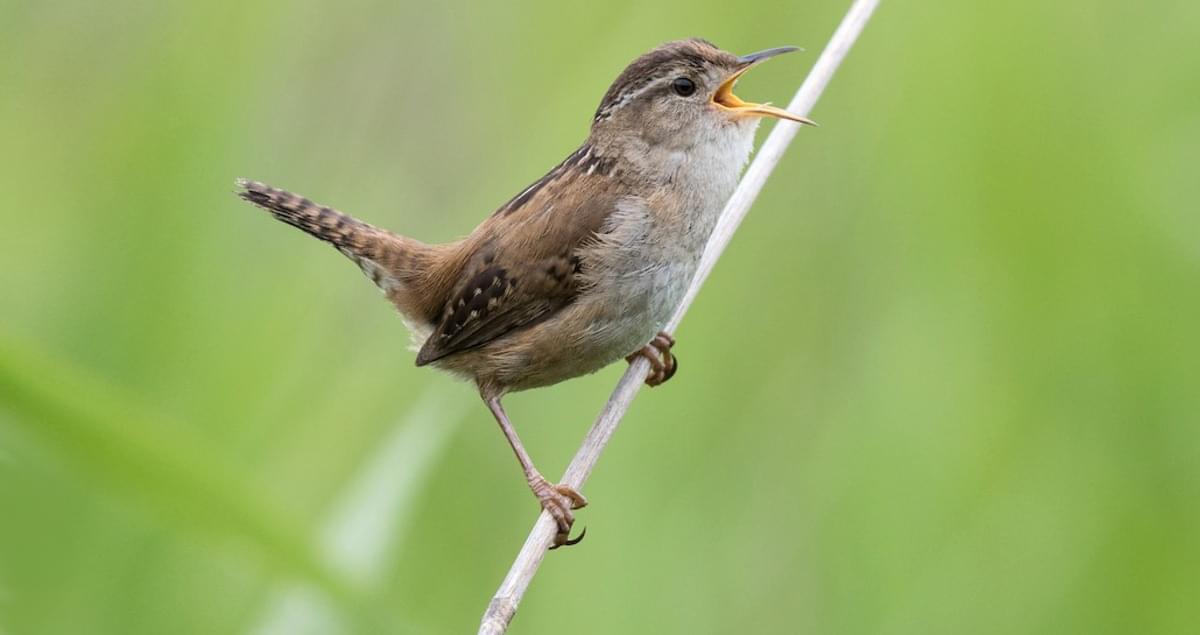In North America, there have been sightings of 11 different wren species, with 7 of them being observed in Nova Scotia. Among the wrens in Nova Scotia, three species are regularly seen, while four are considered accidental. This comprehensive guide aims to assist you in identifying these wrens based on their appearance and vocalizations.
During the summer in Nova Scotia, you can spot Winter Wrens. Additionally, keep an eye out for Carolina Wrens, Marsh Wrens, House Wrens, Sedge Wrens, Rock Wrens, and Bewick’s Wrens.
Wrens may not stand out with their appearance, but they possess charismatic personalities. These brown, relatively small, and plump birds exhibit distinctive upright tails and powerful voices.
Wrens primarily inhabit the New World, encompassing North and South America, except for the Eurasian Wren, which resides in Europe and Africa. They belong to the Troglodyidae family of avian species.
Insects and spiders comprise the bulk of wrens’ diet. This dietary preference allows them to thrive in diverse environments, including arid and rocky regions with sparse vegetation.
Initially, it was believed that the Winter Wren was the same species as the Pacific Wren and the Eurasian Wren. However, they have since been recognized as three distinct species.
Throughout history, wrens have held significance in folklore and cultural symbolism. In Europe, it was once believed that harming wrens would bring about misfortune.
This guide, based on avibase data, will facilitate the identification of wren species in Nova Scotia. The list of wrens provided is arranged based on the frequency of sightings, ranging from the most frequently observed to the least, as reported by birdwatchers using ebird checklists.
The following are the seven wren species found in Nova Scotia:
1. Winter Wren
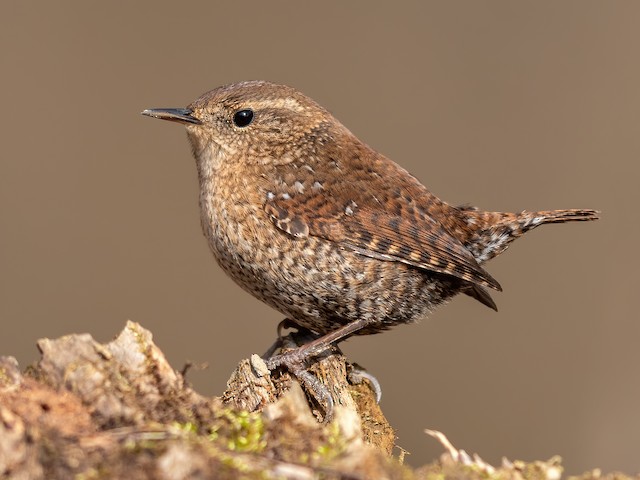
During the breeding season, Winter Wrens are commonly sighted in Nova Scotia, appearing in approximately 5% of summer checklists. They are more prevalent from April to October, but some individuals remain throughout the year.
Winter Wrens are small and plump, sporting brown feathers with darker barring on the wings, tail, and belly. They possess a lighter eyebrow stripe and short tails, which they hold upright. Male and female Winter Wrens share a similar appearance.
Winter Wrens bear a striking resemblance to Pacific Wrens, and they were once considered the same species. However, they have now been classified as separate species with distinct songs.
Scientific name: Troglodytes hiemalis
Length: 3.1-4.7 inches (8-12 cm)
Weight: 0.3-0.4 ounces (8-12 g)
Wingspan: 4.7-6.3 inches (12-16 cm)
Winter Wrens are found in eastern US states during winter and in Canada during summer.
To locate Winter Wrens, search amidst tangled undergrowth in forests and residential backyards. They forage for insects and spiders by rummaging through fallen leaves and decaying tree bark.
Winter Wren sounds: They produce a melodic, bubbly, and sweet song, slower in pace compared to Pacific Wrens, lasting up to 10 seconds.
2. Carolina Wren
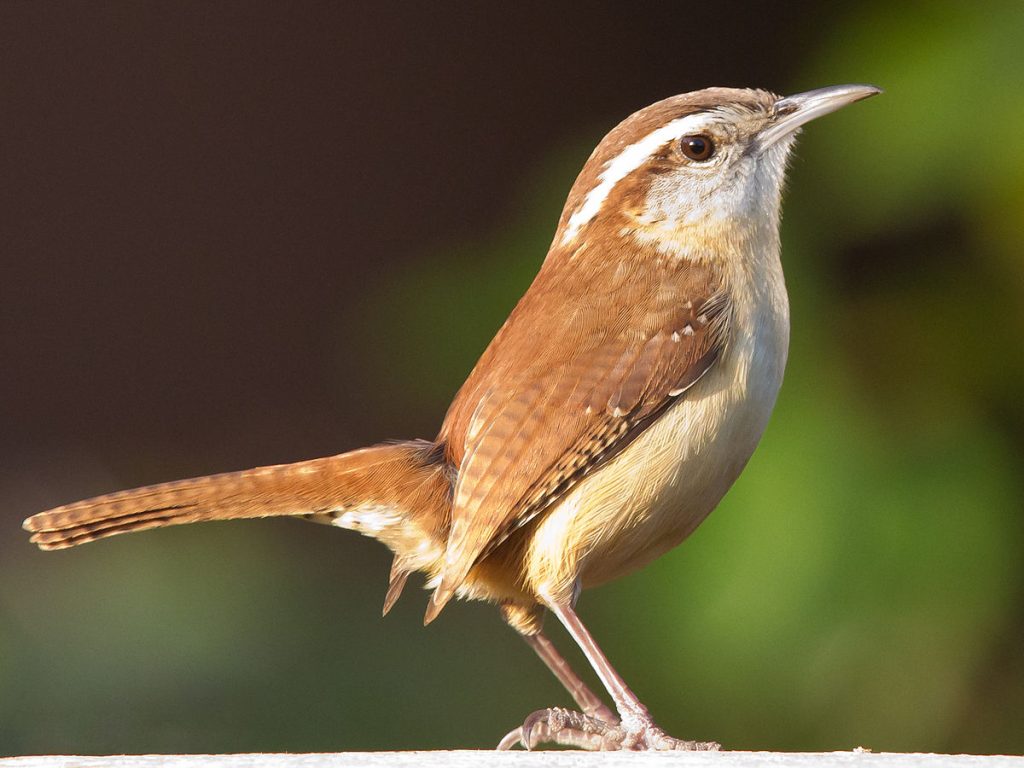
Considered an accidental species in Nova Scotia, Carolina Wrens have recently been observed in the region, although such sightings are infrequent.
Carolina Wrens exhibit a shy nature and feature dark brown feathers on their upper body and lighter brown plumage on their underside. They possess a distinct white eyebrow stripe and an upright tail.
Scientific name: Thryothorus ludovicianus
Length: 4.7-5.5 inches (12-14 cm)
Weight: 0.6-0.8 ounces (18-22 g)
Wingspan: 11.4 inches (29 cm)
Carolina Wrens are year-round residents across Eastern and Southeastern States.
You can find Carolina Wrens in wooded areas or dense vegetation, and they may visit backyard feeders. Their diet primarily consists of insects and spiders, but they occasionally consume lizards, frogs, and snakes.
Carolina Wren sounds: Their song comprises quick whistles delivered in a short sequence.
3. Marsh Wren
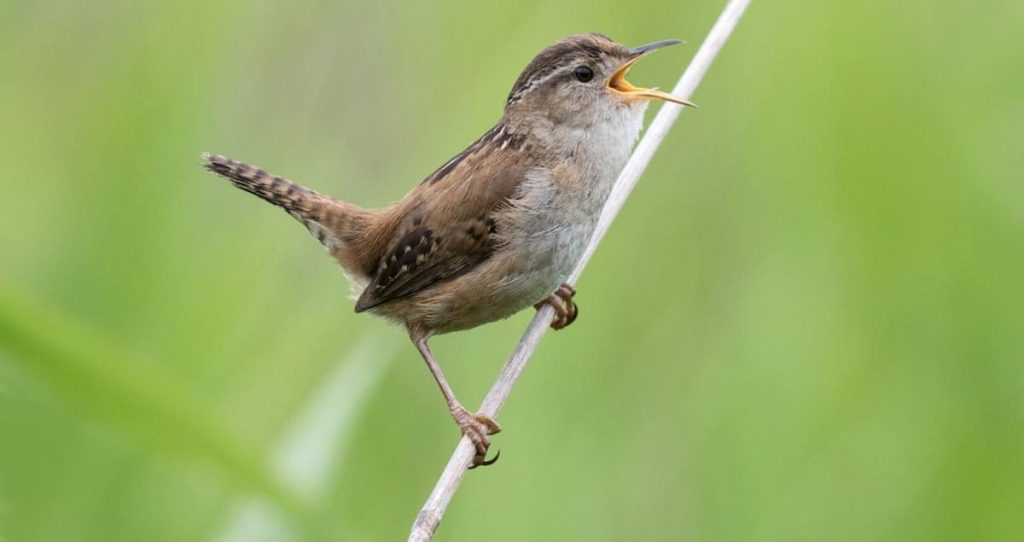
Marsh Wrens are rarely observed in Nova Scotia, but they are categorized as regularly occurring and have been spotted around Yarmouth recently.
Marsh Wrens possess brown feathers with black and white streaks on their back. Their undersides are grayish brown, and they exhibit the signature upright tail of wrens.
Unlike Sedge Wrens, Marsh Wrens lack striped shoulders and possess longer bills. Male and female Marsh Wrens share similar appearances.
Scientific name: Cistothorus palustris
Length: 3.9-5.5 inches (10-14 cm)
Weight: 0.3-0.5 ounces (9-14 g)
Wingspan: 5.9 inches (15 cm)
Marsh Wrens breed in Northern US states and Central Canada, migrating to Southern states and Mexico. Some individuals along the Atlantic Coast and in the western region remain resident throughout the year. Marsh Wrens can be spotted during migration in the Eastern US.
You can find Marsh Wrens in wetlands, where they cling to reeds with each foot gripping a different stalk. They may be challenging to spot, but listen for their songs amidst the reeds, particularly during dawn and dusk.
Marsh Wren sounds: They produce a distinctive buzzy song that can extend for up to 20 minutes.
4. House Wren
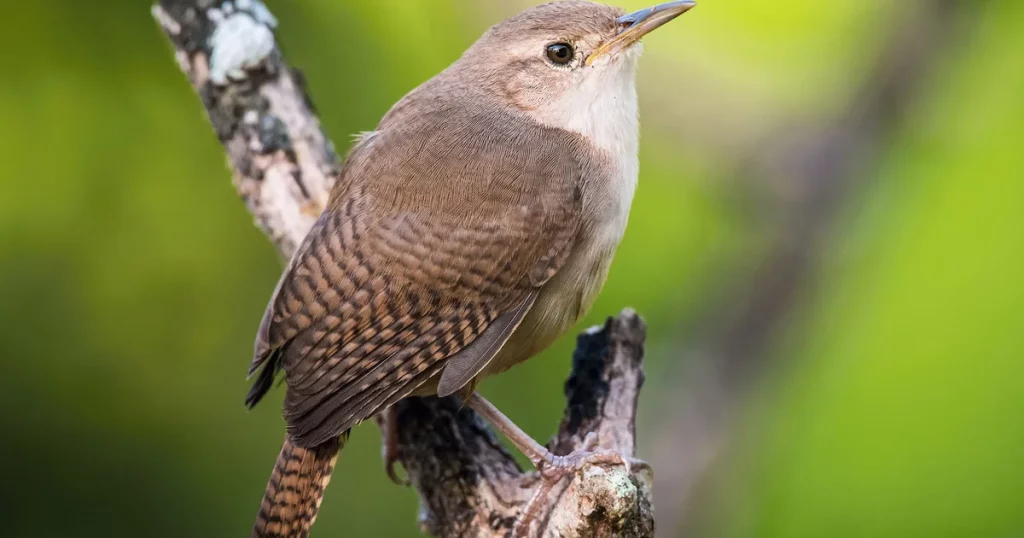
House Wrens are accidental species in Nova Scotia, but recent sightings have been reported around Yarmouth.
House Wrens are small, round, and unremarkable in appearance, featuring brown feathers with darker barred wings and tails. They exhibit a paler throat. Male and female House Wrens share a similar appearance.
Scientific name: Troglodytes aedon
Length: 4.3-5.1 inches (11-13 cm)
Weight: 0.3-0.4 ounces (10-12 g)
Wingspan: 5.9 inches (15 cm)
During the summer, House Wrens breed in the US and Southern Canada before migrating to The South and Mexico for winter.
Look for House Wrens in backyards, parks, and open woodlands, where they actively search for insects and spiders. You can often spot them energetically hopping through tangles and low branches with their tails held high while singing their cheerful song.
House Wren sounds: Their songs consist of a series of jumbled notes that vary in pitch and speed, lacking a specific tune.
5. Sedge Wren
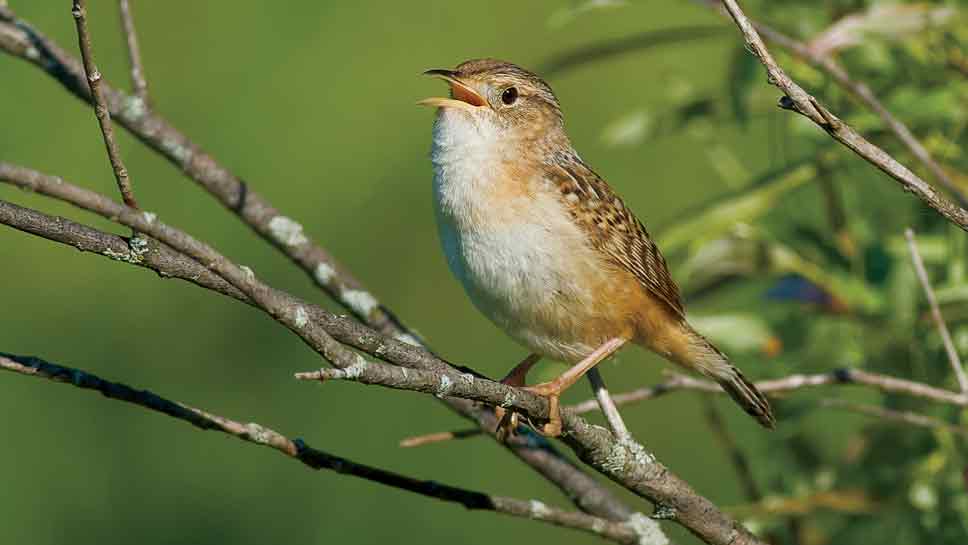
Sedge Wrens are rarely seen in Nova Scotia, but they are regularly occurring. In 2021, sightings were recorded around Cape Forchu.
Sedge Wrens are small brown wrens with darker streaks and barring on their upper body and paler feathers underneath. They possess a light eyebrow stripe. Male and female Sedge Wrens exhibit similar appearances.
Compared to Marsh Wrens, Sedge Wrens can be found in similar wet areas. However, Marsh Wrens lack striped shoulders and have lighter bellies.
Scientific name: Cistothorus stellaris
Length: 3.9-4.7 inches (10-12 cm)
Weight: 0.3-0.3 ounces (7-10 g)
Wingspan: 4.7-5.5 inches (12-14 cm)
Sedge Wrens breed in southern Canada, the Midwest, and occasionally further east in the US. They migrate to spend winters in southeastern states and northern Mexico, near the Gulf and Atlantic coast.
You can find Sedge Wrens concealed in wet grasslands, marshy areas, and meadows with dense vegetation. They typically prefer shallower areas than Marsh Wrens and hunt for insects and spiders.
Sedge Wren sounds: Their song is simple, comprising a few short notes followed by a rapid series of similar-pitched notes.
6. Rock Wren
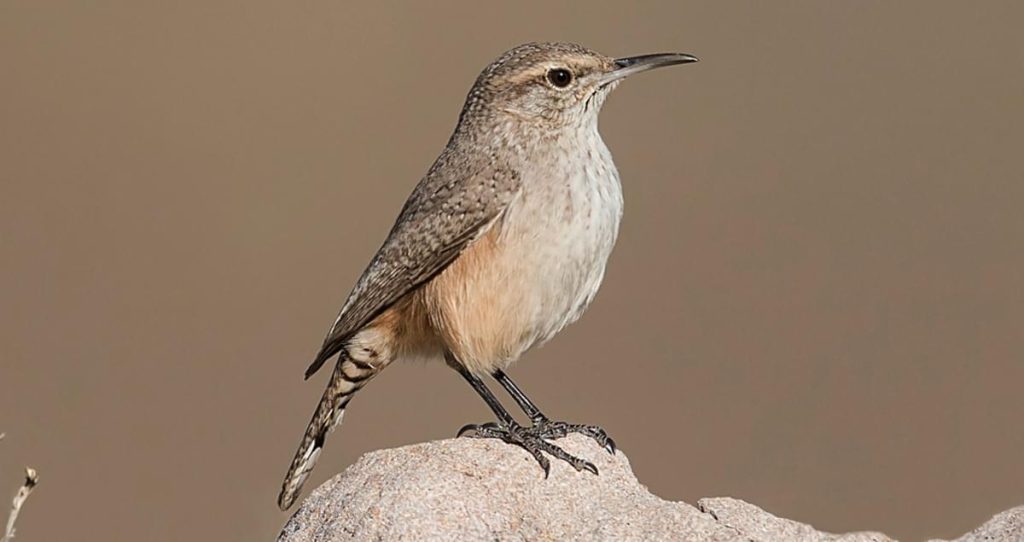
Rock Wrens are considered accidental species in Nova Scotia, with sightings reported in Halifax in 2020.
Rock Wrens exhibit pale brown feathers on their back with darker flecks. They possess barred wings and tail and a pale underside, with buff coloring on the lower flanks and belly.
Scientific name: Salpinctes obsoletus
Length: 4.9-5.9 inches (12.5-15 cm)
Weight: 0.5-0.6 ounces (15-18 g)
Wingspan: 8.7-9.4 inches (22-24 cm)
Rock Wrens inhabit dry and rocky areas in western US states and southwest Canada. While individuals in the south and west remain resident throughout the year, those in central US states migrate south for winter.
Search for Rock Wrens in arid and rocky environments with minimal vegetation. They feed on insects found in crevices between rocks.
Rock Wren sounds: They possess a repertoire of over 100 songs, often repeating the same sound multiple times before transitioning to a different sound. Each rendition varies in pitch.
7. Bewick’s Wren

Bewick’s Wrens are extremely rare and considered accidental species in Nova Scotia. According to records, they have not been sighted in the region for quite some time.
Bewick’s Wrens feature brown feathers on their back with long gray upright tails exhibiting darker barring. Their bellies are gray, and they possess a white stripe above the eye.
Scientific name: Thryomanes bewickii
Length: 5.1 inches (13 cm)
Weight: 0.3-0.4 ounces (8-12 g)
Bewick’s Wrens reside year-round in southern and western states, with some minor movements during winter.
You can find Bewick’s Wrens in scrubland, thickets, and open woodlands, where they hop from branch to branch, showcasing their flicking long tails.
They primarily feed on insects and larvae, including bees, bugs, caterpillars, and beetles.
Bewick’s Wren sounds: Their song begins with a couple of short higher notes followed by lower-pitched buzzy notes.
To attract wrens to your backyard, create suitable habitats for insects and spiders by maintaining fallen leaves and brush piles. Additionally, provide clean water sources in multiple locations, such as running water. Wrens also appreciate nesting sites, whether in nest boxes or even old boots left out. Supplement their diet by offering mealworms, crickets, peanuts, and suet.
How to Attract Wrens to Your Backyard
Attracting wrens to your backyard can be a rewarding experience, allowing you to enjoy their beautiful songs and observe their lively behavior up close. While only a few species of wrens regularly visit backyards, such as House Wrens, Carolina Wrens, and Bewick’s Wrens, there are several steps you can take to increase the chances of attracting them:
1. Embrace a bit of untidiness: Wrens are fond of habitats rich in insects and spiders, which form their favorite food source. Leave fallen leaves and create brush piles in your yard, as they provide excellent hiding places for prey and attract wrens.
2. Provide clean water sources: Wrens, like other birds, require access to water for drinking and bathing. Consider setting up birdbaths or small water features with running water in different locations throughout your yard.
3. Offer nesting sites: Wrens readily use nest boxes and may even make use of unconventional structures like old boots. Providing suitable nesting opportunities can attract wrens to your backyard. Make sure to position nest boxes at appropriate heights and protect them from predators.
4. Supplement their diet: Wrens have a diverse diet that includes insects, spiders, and other small invertebrates. You can enhance their foraging opportunities by offering mealworms, crickets, peanuts, and suet in feeders or scattered around your yard.
By implementing these practices, you can create an inviting environment that attracts wrens to your backyard, providing you with delightful interactions and a chance to appreciate these charming songbirds.
